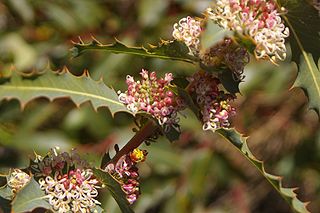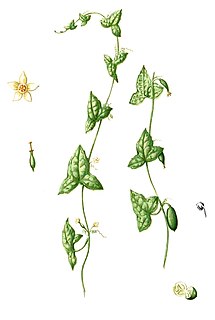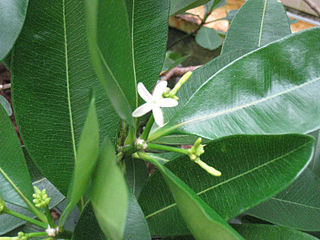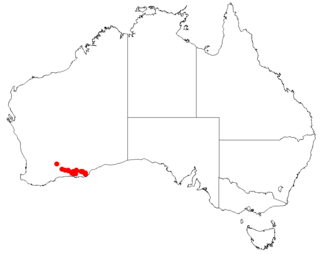
Murraya paniculata, commonly known as orange jasmine, orange jessamine, china box or mock orange, is a species of shrub or small tree in the family Rutaceae and is native to South Asia, Southeast Asia and Australia. It has smooth bark, pinnate leaves with up to seven egg-shaped to elliptical leaflets, fragrant white or cream-coloured flowers and oval, orange-red berries containing hairy seeds.

Blandfordia grandiflora, commonly known as Christmas bells, is a flowering plant endemic to eastern Australia. It is a tufted perennial herb with narrow, channelled, linear leaves and between two and twenty large, drooping, bell-shaped flowers. The flowers are red with yellow tips, or sometimes entirely yellow. It is one of four species of Blandfordia known as Christmas bells, this one growing on the coast and nearby ranges between Sydney in New South Wales and Fraser Island in Queensland.

Hakea amplexicaulis, commonly known as prickly hakea, is a shrub endemic to south west Western Australia. An attractive small shrub with unusual stem clasping, sharply serrated foliage and a profusion of sweetly scented variable coloured flowers from late winter to spring.

Eucalyptus alba, commonly known as white gum, khaki gum or poplar gum, is a species of tree that is native to Australia, Timor, and New Guinea. It has smooth bark, lance-shaped to egg-shaped leaves, flower buds in groups of seven, white flowers and conical to hemispherical fruits.
Zeuxine exilis, commonly known as Ridley's jewel orchid or the slender jewel orchid, is a species of orchid that is endemic to Christmas Island where it grows in rainforest. It has three or four egg-shaped leaves and up to thirty small, dull reddish flowers crowded along a thin, hairy flowering stem. It was first recorded in 1904 but was not seen again until 2009.

Zehneria is a genus of flowering plants – of vines in the cucumber and gourd family, Cucurbitaceae. It contains about 35 species ranging from Africa, through Southeast Asia to Australia and Oceania. The name honours botanical artist Joseph Zehner.
Zehneria baueriana, commonly known as the native cucumber or giant cucumber, is a species of flowering plant – a vine in the cucumber and gourd family, Cucurbitaceae. It is found on Norfolk Island, an Australian territory in the Tasman Sea, as well as in New Caledonia. The specific epithet honours Austrian botanical illustrator Ferdinand Bauer who collected on Norfolk Island in 1804 and 1805.

Hoya aldrichii , commonly known as the Christmas Island Waxvine is a species of flowering plant in the Apocynaceae or dogbane family. It is a vine that is endemic to Christmas Island, an Australian territory in the north-eastern Indian Ocean, where it is a common epiphyte in the shrublands of the island's coastal terraces. The specific epithet honours Captain Aldrich, commander of the survey vessel HMS Egeria, which visited Christmas Island in 1887.
Pandanus elatus is a dioecious tropical plant in the screwpine genus. It is endemic to Christmas Island, an Australian territory in the north-eastern Indian Ocean. Its specific epithet comes from the Latin elatus (tall), in reference to its growth habit.
Asystasia alba is a species of tropical herb in the family Acanthaceae. It is endemic to Christmas Island, an Australian territory in the north-eastern Indian Ocean. Its specific epithet comes from the Latin alba (white), referring to the colour of its flowers.
Dicliptera maclearii is a species of plant in the family Acanthaceae which is endemic to Christmas Island, an Australian territory in the north-eastern Indian Ocean. Its specific epithet honours John Maclear, captain of the survey vessel HMS Flying Fish, which visited Christmas Island in 1886.
Grewia insularis is a species of flowering plant in the Malvaceae, or mallow family, that is endemic to Christmas Island, an Australian territory in the north-eastern Indian Ocean. Its specific epithet is the Latin for insular, referring to its island location.
Brachypeza archytas, commonly known as the sage orchid, is an epiphytic orchid that is endemic to Christmas Island, an Australian territory in the north-eastern Indian Ocean. It has many cord-like roots, four or five leaves arranged like a fan and a large number of small, crowded, short-lived, white flowers.
Dendrobium nativitatis, commonly known as the Christmas Island crimp orchid, is a species of epiphytic orchid that is endemic to Christmas Island, an Australian territory in the north-eastern Indian Ocean. It has long, straggly stems, flattened pseudobulbs, a single leathery leaf and a single pale yellow flower.

Ochrosia ackeringae is a species of flowering plant in the family Apocynaceae that is found in the Malesian region. The specific epithet honours the collector of one of the syntypes.

Ehretia microphylla, synonym Carmona retusa, also known as the Fukien tea tree or Philippine tea tree, is a species of flowering plant in the borage family, Boraginaceae.

Persoonia cymbifolia is a species of flowering plant in the family Proteaceae and is endemic to the south of Western Australia. It is an erect, spreading shrub with smooth bark, hairy young branchlets, linear to narrow oblong leaves and yellow flowers borne singly or in groups of up to three on a short rachis.

Hakea conchifolia, commonly known as the shell-leaved hakea is a shrub in the family Proteaceae native to an area in the west coast of the Wheatbelt region of Western Australia. An attractive small species with unusual rigid leaves that encircle the flowers.
Microtis alba, commonly known as the white mignonette orchid or slender onion-orchid, is a species of orchid endemic to the south-west of Western Australia. It has a single hollow, onion-like leaf and up to sixty small, green and white flowers with a strong musky fragrance. It is much more common after a fire the previous summer than in unburned country.

Hakea oldfieldii is a shrub of the family Proteaceae and is endemic to South West region of Western Australia. It has small white or cream-yellow flowers in profusion in spring.










